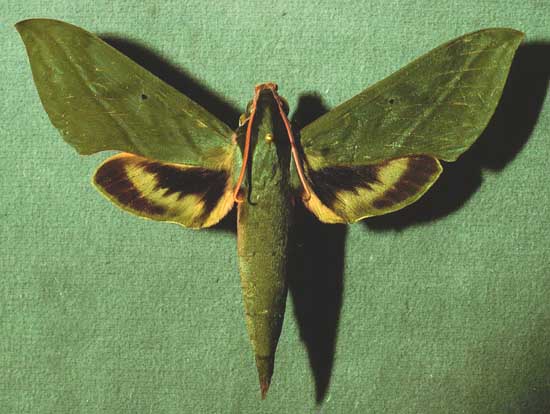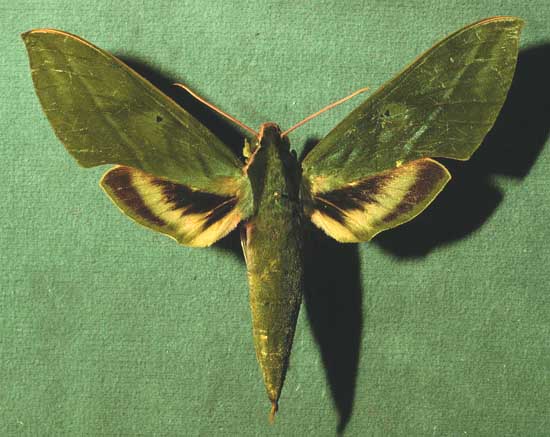Xylophanes belti
|
|
Updated as per Catalogo de las Especies de Sphingidae en Honduras, Ana Clariza Samayoa and Ronald D. Cave;
December 2009
|
Xylophanes belti
zail-AH-fan-eesmm
BELT-eye
or
zye-LAH-fan-eesmm
BELT-eye
(Druce, 1878) Chaerocampa [sic]

Xylophanes belti male courtesy of Dan Janzen.
This site has been created by
Bill Oehlke at oehlkew@islandtelecom.com
Comments, suggestions and/or additional information are welcomed by Bill.
TAXONOMY:
Family: Sphingidae, Latreille, 1802
Subfamily: Macroglossinae, Harris, 1839
Tribe: Macroglossini, Harris, 1839
Genus: Xylophanes Hubner [1819] ...........
Species: belti (Druce, 1878)
|
MIDI MUSIC
.....It's a Wonderful World.....
copyright C. Odenkirk
ON.OFF
<bgsound src="world.mid" LOOP=FOREVER>
|
DISTRIBUTION:
Xylophanes belti moths
[wingspan 90-95 mm, females larger than males]
fly in
Nicaragua (specimen type locality);
Costa Rica;
Belize: Cayo, Stann Creek, Toledo;
Mexico;
Honduras: Atlántida, Cortés, Gracias a Dios,
Yoro (35m-1600m);
Guatemala: Izabal (JM); and
probably throughout most of Central America.
"Rothschild Jordan (1903) referred to Xylophanes belti as “One of the finest species”; certainly cannot be confused with any other species of Xylophanes.
Uppersides of forewings, head, thorax and abdomen deep olive green; a stripe from the forewing base to palp, a lateral patch on the abdomen basally and the undersides of the
body and wings deep carmine-red.
Abdomen with traces of 2 rows of dorsal dots ventrally. Outer spur of midtibia little shorter than inner.
Forewing upperside deep olive green, interspaces with a silky blue-grey gloss; three antemedian lines, second and third merged together; postmedian lines indistinct,
third and fourth separated by a conspicuous, straight, silky blue-grey line.
Median band pale olive green, fading to greenish-buff." CATE
FLIGHT TIMES:
Xylophanes belti adults have been taken every month (except March) of the year in Costa
Rica.
ECLOSION:
Pupae probably wiggle to surface from subterrqnean chambers just prior to eclosion.

Xylophanes belti female courtesy of Dan Janzen.
SCENTING AND MATING:Females call in the males with a pheromone released from a gland at the tip of the
abdomen. Males come in to lights very readily, but females are seldom taken in that way.
EGGS, LARVAE, PUPAE:
Larvae probably feed on Psychotria panamensis and Psychotria nervosa
of the Rubiaceae family and on
Pavonia guanacastensis of the Malvaceae family.
Moths emerge approximately one-two months after larvae pupate.
The pronunciation of scientific names is
troublesome for many. The "suggestion" at the top of the page is
merely a suggestion. It is based on commonly
accepted English pronunciation of Greek names and/or some
fairly well accepted "rules" for latinized scientific names.
The suggested pronunciations, on this page and on other pages,
are primarily put forward to assist those who hear with internal
ears as they read.
There are many collectors from different countries whose
intonations and accents would be different.
Jean Marie Cadiou writes, "When I say "Xylophanes" in English I
pronounce it something like "Zailophanees", with the emphasis on the
"o". The French pronounce it differently, something like
"Kzeelophaness" with no emphasis, and the Germans yet in a
different way..."
In Greek myth, Phanes is the golden winged Primordial Being who
was hatched from the shining Cosmic Egg that was the source of the
universe. He personifies light emerging from chaos.
"Xylo" is the Greek word for wood.
The specimen type for the genus
Xylophanes is Xylophanes anubus. Perhaps ? when Hubner
examined this species, the yellow-orange and brown tones of the
forewings suggested wings of wood.
The species name "belti" probably comes
from Belti, a Babylonian goddess of the morning and evening star
‘star of Istar’. She descends, extinguishing all life, into
the depths of the underworld, from which she is freed by Ea.
Jean-Michel Maes writes (April 30, 2007), "In the origin of the name, my guess
is that it is in honor of Thomas Belt."
Thomas Belt was an English geologist and naturalist who died in 1978.
I suspect Jean-Michel is correct.
Use your browser "Back" button to return to the previous page.
Goto Main Sphingidae Index
Goto Macroglossini Tribe
Goto Central American Indices
Goto Carribean Islands
Goto South American Indices
Goto U.S.A. tables
Use your browser "Back" button to return to the previous page.
This page is brought to you by
Bill Oehlke and the
WLSS. Pages are on space rented from Bizland. If you would like
to become a "Patron of the Sphingidae Site", contact Bill.
Please send sightings/images to Bill. I will do my best to respond to
requests for identification help.
Enjoy one of nature's wonderments: Live
Saturniidae (Giant Silkmoth) cocoons.
 | 
Show appreciation for this site by clicking on flashing butterfly to the left.
The link will take you to a page with links to many insect sites. |



